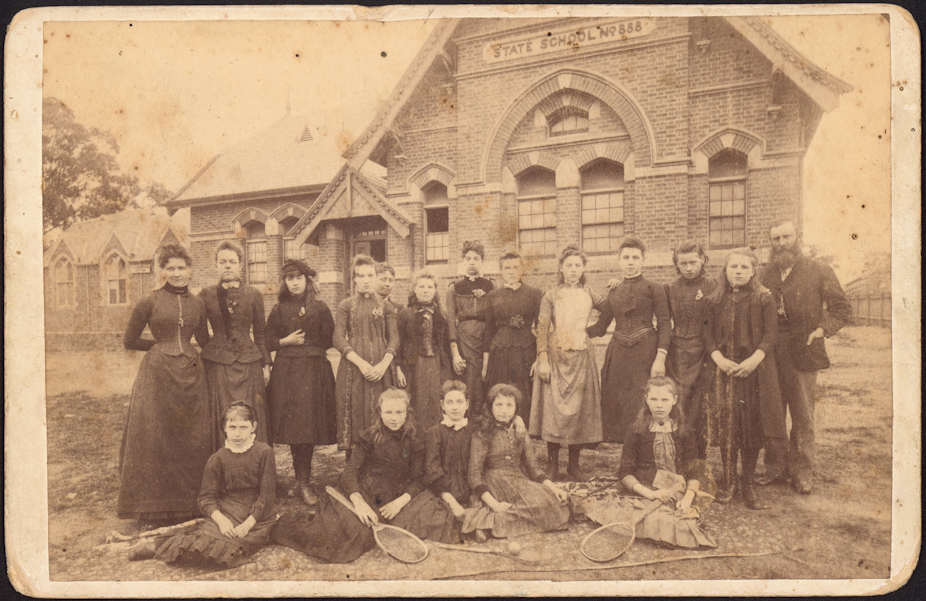If you had to argue for the merits of one Australian book, one piece of writing, what would it be? Welcome to our occasional series in which our authors make the case for a work of their choosing. See the end of this article for information on how to get involved.
From David Copperfield to Holden Caulfield, most canonical coming-of-age novels depict boys becoming men. Jane Eyre’s traumatic journey to adulthood is considered a female version of the Bildungsroman, or novel of development. Yet books about girls are most commonly seen as only weighty enough for girls themselves to read.
Henry Handel Richardson’s The Getting of Wisdom is remarkable because it is one of few novels about a girl’s maturation that has come to be understood as a “classic” and also because it is ultimately a girls’ school story. HG Wells, who described the protagonist Laura Tweedle Rambotham as “an adorable little beast”, considered the book to be the best school story he’d ever read.
But was Wells paying Richardson a great compliment? The genre of school stories is maligned and rarely considered as literature. The school story is often seen as originating with Thomas Hughes’s Tom Brown’s Schooldays (1857), but actually has a significantly longer history, providing moral instruction to girls from the mid-18th century.

Set in the 1890s, but published in 1910, The Getting of Wisdom defiantly flouts the conventions of the British girls’ school story that were established by the first decades of the 20th century. Typically, a “new girl” confronts a school community in which she does not fit; after many trials she conforms to the system of rules among peers and teachers and is finally accepted. The once unruly or misunderstood girl caps off her first year with a victory for the school in a tennis tournament, or by acing her exams.
When Richardson, a female writer who wrote under a man’s name, transports a new girl from the country to the Ladies’ College in Melbourne, she sets about undermining the very concepts of unity, friendship, honesty, and diligence on which girls’ school stories depend.
Laura learns little from her own mistreatment at the hands of others. After her tumultuous introduction to the College, Laura rejoices “in barbarian fashion” when another new girl, the daughter of a millionaire squatter, is similarly snubbed by other students.
Her crimes are many. Torn between a desire to belong and ambivalence about several of the girls around her, Laura concocts an enthralling tale about the happily married curate’s romantic interest in her. Desperate not to devastate her widowed mother, who has laboured and sacrificed to fund her daughter’s education, Laura seizes the opportunity to stuff a history book down her dress and cheat in one of her final exams.
Her punishments are few. While Laura is ostracised after her most flamboyant lie, there are no lingering consequences for her deceptions. She enters school at the age of 12 as a “square peg” and leaves after several years without her edges having been rounded in the slightest.

At the novel’s outset, Laura’s mother cautions that schooling heralds the end of childhood and that Laura must now “learn to behave in a modest and womanly way”. Girls of the period were socialised into traditional feminine expectations of marriage and motherhood.
But, as critic Sally Mitchell shows in her book The New Girl, some Victorian and Edwardian fiction presents girlhood as a liminal state that brings with it freedom from gendered restrictions. There are many things that a girl can get away with without being seen as unfeminine that a woman cannot.
The novel encourages the reader to value Laura’s minor acts of rebellion, such as when she refuses to eat an apple foisted upon her by a condescending woman during her first journey to school. Laura subsequently hurls the despised apple out of a train carriage toward a telegraph post.
Likewise, her lack of interest in boys a not represented as a failing. When the attractive Bob is unexpectedly “gone” on Laura, she is irritated that she now has to “fish for him” and fails at her feeble attempts at flirtation. A number of the older girls have men waiting for them to finish school and have already “reached the goal” of womanhood that seems strange and distant to Laura.
Australia’s most celebrated literary girl rebel, Sybylla Melvyn in Miles Franklin’s My Brilliant Career (1901), flees expectations of marriage to follow her writing dreams. Laura remains too young to receive marriage proposals, but Richardson briefly reveals that the end of girlhood can promptly close off the excitement of a future of seemingly infinite possibilities. Laura’s friend M.P. aspires to take several degrees, but soon after leaving school she has returned to her home town, is married, and has been “forced to adjust the rate of her progress to the steps of halting little feet”.
The Getting of Wisdom grants Laura, like Sybylla, an ambiguous ending. The reader does not witness the death of girlhood freedoms, but watches Laura run without care, as she departs school for the final time, down a straight path and then around a bend, out of sight.
We know little about her future, other than that “even for the squarest peg, the right hole may ultimately be found”.
Are you an academic or researcher? Is there an Australian book or piece of writing – fiction or non-fiction, contemporary or historical – you would like to make the case for? Contact the Arts + Culture editor with your idea.
Further reading:
The case for Kim Scott’s That Deadman Dance
The Case for John Bryson’s Evil Angels
The case for Sheilas, Wogs and Poofters by Johnny Warren

